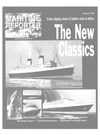
PropacRudder Benefits Confirmed In Service
Wartsila NSD has recently completed shipboard trials with the new Wartsila NSD PropacRudder. and results are promising, according to the manufacturer.
The innovative propulsion system, originally introduced a little more than a year ago, was designed to reduce propulsive power requirement, with reduced hull vibration and noise, while providing for exceptional maneuverability. The trials, undertaken last October and November aboard the 5,175-dwt paper carrier Lysbirs, reportedly confirm all of this. Norwegian owner Lys-Line AS of Oslo was the willing test partner (it should be noted that Norwegian owners are renowned for their willingness to work with the industry in the proving of new concepts), and the vessel was equipped with a Propac propulsion package, which consisted of a 6,300 kW Wartsila 6L46C medium speed diesel engine, a 4.5 m diameter Wartsila CP propeller, gearbox and PropacRudder. The PropacRudder's signature is its streamlined torpedo shaped bulb on the rudder horn. The bulb is designed to ensure a more homogeneous water flow both in front of the propeller and in the propeller slipstream. The bulb is designed to increase propulsion efficiency via a wake gain effect, meaning that it reduces the water speed into the propeller so that less power is needed to produce the same thrust. The bulb also has been shown to reduce propeller-induced hull noise and vibration by eliminating hub vortices and separation, and cavitation behind the propeller hub collapsing on the propeller. While model tests showed that solely by applying the PropacRudder. the presence of the bulb gives a large reduction in power of about 10 percent for the same ship speed compared to using conventional flap rudders, the full-scale trials actually demonstrated an even greater power savings. It was noticeable during the trial on Lysbris that propeller-induced noise level is very low right across the range of pitch settings with constant propeller revolutions, without any noisy face cavitation or local hull vibration problems. Also of note was the vessel's maneuverability, particularly during low-speed operation and in restricted waterways. At low ship speeds, event in high winds and fast currents, the vessel was kept under control. In the trial, it was found that the ship can be maneuvered safely at speeds down to just one knot, even in strong currents. The next vessel to enter service with the PropacRudder is the 14,000-dwt chemical tanker Jo Laguna D from Italy's De Poli Yard.
Circle 4 1 on Reader Service Card
Read PropacRudder Benefits Confirmed In Service in Pdf, Flash or Html5 edition of February 2000 Maritime Reporter
Other stories from February 2000 issue
Content
- Bergesen Orders Four Tankers From Hitachi page: 7
- Chuan Hup Unit Secures PB Contract page: 7
- A model approach from the Swedes page: 8
- Innovative class for the banana trade page: 9
- Propeller Milestone Achieved By U.S. Navy page: 10
- Propeller & Shafting Symposium Planned page: 11
- PropacRudder Benefits Confirmed In Service page: 12
- E&P Spending 2000: Boom or Bust? page: 14
- New Government Statistics Show Larger, Diverse Fleet page: 15
- ATB Delivered by Alabama Shipyard page: 16
- Cruise Shipping Annual The New "Class" of Celebrity's Class page: 19
- Cunard Creates The Classic Liner (Again) page: 24
- Cruise Industry Leaders To Convene At SeaTrade page: 25
- Cruise Share Performance page: 26
- Litton Marine Systems Supplies IBS Order page: 27
- MSC Europe Experiencing Steady Growth Stream page: 27
- James P. Colie Completes Cruise Ships Refurbish page: 29
- New Cruise Ship Designs Impact Terminal Ops And Logistics page: 31
- Royal Caribbean Commits To Environmental Endeavors page: 34
- Superseacat Service To Be Launched page: 35
- Strong Finish To A Strong Year In Oslo page: 37
- New MaK M 43 Series Aids German Branch page: 38
- Isotta Fraschini Marine Diesel Engines Available on W. Coast page: 38
- DeJong & Lebet Assists On Vessel Conversion page: 40
- Coastal AIS Stations with Radars: High-Efficiency Monitoring Facility page: 44
- Supporting The Technical Revolution page: 46
- Cadkey 99 Offers Powerful Features page: 48
- Where Businesses And Consumers Can Mix page: 48
- BT Unveils E-Commerce Site page: 48
- Finnish Innovation Ascends New Heights page: 50
- AKER FINNYARDS page: 50
- Keeping Machinery Spaces Safe page: 53
- Kvaerner Masa-Yards Delivers page: 54
- Record Trade Surplus Boosted By Shipsales page: 55
- Allied Systems Delivers SOLAS Approved Davit page: 55
- GDHS Launches Friobox Express page: 56
- Schoellhorn-Albrecht Supplies Deck Equipment page: 58
- Golden Ocean Reaches Agreement; Announces Resignation page: 58
- GD Appoints Welch As Snr. VP page: 60
- Furuno Introduces CH-37 Sonar page: 60
- STN Introduces New Speed Log page: 60
- NASSCO Lands First Phase Of Ship Conversion page: 65
- Derecktor Shipyard Wins Contract For Two Pilot Boats page: 66
- Gladding-Hearn to Deliver Largest Incat Fast Ferry page: 67
- Bollinger Launches Ocean Intervention II page: 70
- SeaArk Delivers Commander To Passaic Valley page: 70


